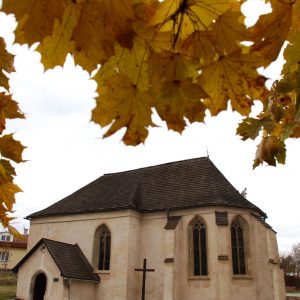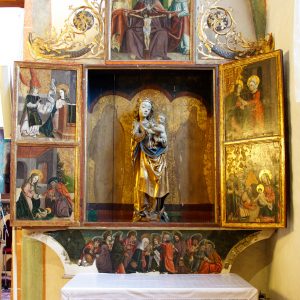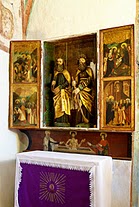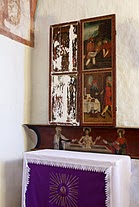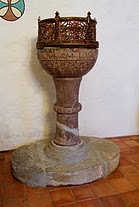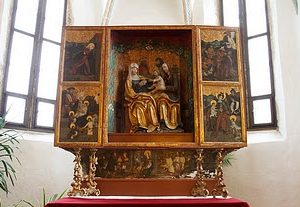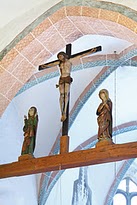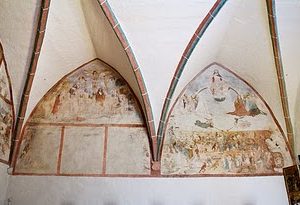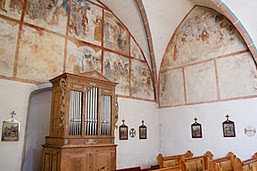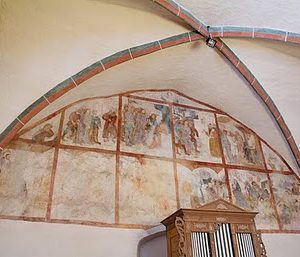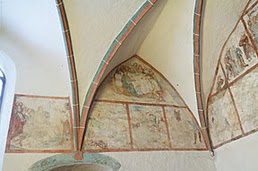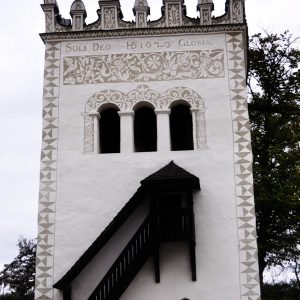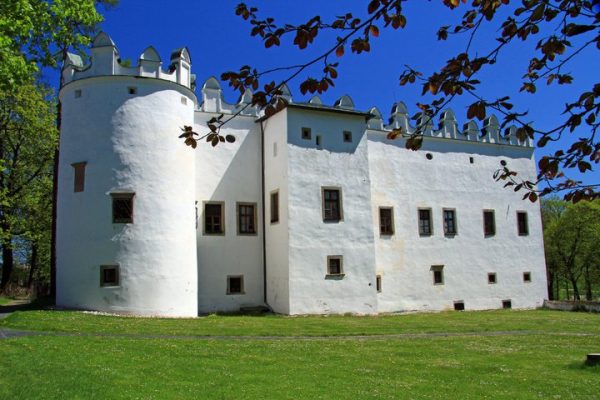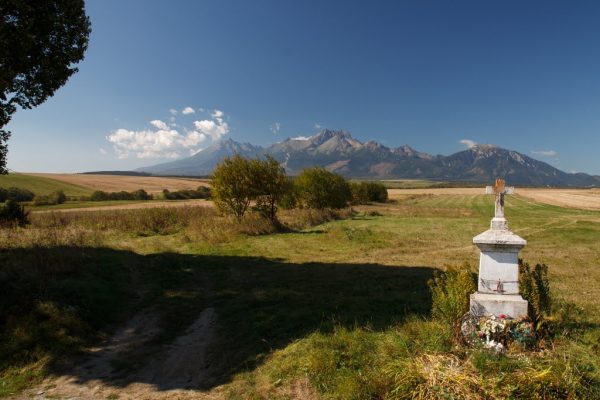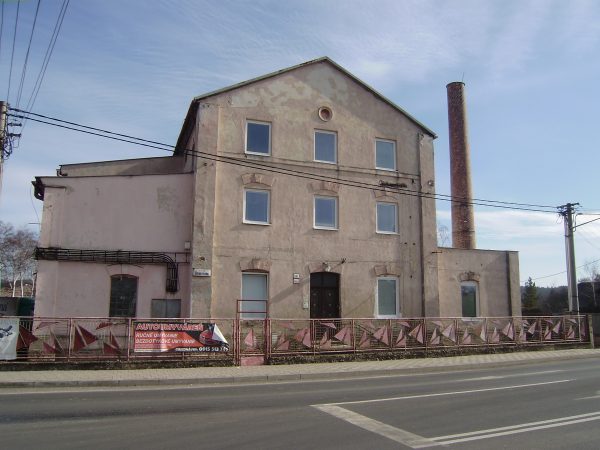20. Rímskokatolícky Kostol sv. Anny v Strážkach a zvonica
![]() Vitajte v unikátnom priestore 3 národných kultúrnych pamiatok v mestskej časti Spišskej Belej – v Strážkach. Pozývame Vás na prehliadku neskorogotického rímskokatolíckeho Kostola sv. Anny.
Vitajte v unikátnom priestore 3 národných kultúrnych pamiatok v mestskej časti Spišskej Belej – v Strážkach. Pozývame Vás na prehliadku neskorogotického rímskokatolíckeho Kostola sv. Anny.
Kostol bol postavený v polovici 14. storočia. Tvorila ho jednoduchá stavba veže, z ktorej sa doteraz zachovala loď, ktorej dĺžka je 17 m a šírka 8,5 m. Je zaklenutá dvoma poľami krížovej klenby na stredný pilier. Jeho staršie presbytérium (svätyňa) štvorcového pôdorysu bolo v tretej tretine 15. storočia prestavané do súčasného neskorogotického presbytéria s jedným poľom krížovej klenby uzavreté polygonálnym uzáverom, zvonku podopreté vencom prípor. Na južnej strane je sakristia a k lodi prístavba krypty z roku 1706. V západnej stene lode sa nachádza zamurovaný pôvodný vstupný gotický portál. V exteriéri kostola bol cintorín, ktorého stredoveký ohradový múr bol čiastočne zrekonštruovaný v roku 2010.
Spiš sa preslávil najmä vzácnymi gotickými pamiatkami. Obyvatelia sa tu už od 16. storočia hlásili k evanjelickému vierovyznaniu. Do Strážok ho priniesla rodina Horvátovcov-Stančičovcov, ktorá bola už od svojho príchodu do týchto končín nadšenou šíriteľkou reformačných myšlienok. Gregor Horvát-Stančič bol jedným z hlavných predstaviteľov tzv. umiernenej reformácie. Keďže ako zemepán bol zodpovedný za svojich poddaných a bol aj patrónom cirkvi. Z toho preňho vyplývala povinnosť starať sa o kostol, faru i kňaza. Práve oltáre hrali dominantnú úlohu v obžalobách predstaviteľov reformácie. Žiaľ, veľa pamiatok bolo práve v tomto období zničených. Stančič v Strážkach tieto chrámové umelecké predmety zhromažďoval. Bol to vzdelaný a rozhľadený muž, ktorý takto uchoval a zachránil množstvo umeleckohistorických artefaktov. Kostol sa znovu vrátil katolíkom až v roku 1673. Hlavný oltár sv. Anny je z rokov 1500 – 1520, s dvojicou pohyblivých krídel. Oltár je skvelým súborným dielom maliara, rezbára i stolára stredovekého umenia. V spodnej časti je namaľovaná kompozícia hlavného súsošia sediacej Panny Márie s Ježiškom na rukách a matkou Panny Márie sv. Annou, ktorá podáva Ježiškovi dnes už stratené vladárske jablko. Svätá Anna bola matkou Panny Márie a manželkou sv. Joachima. Jej atribútmi bola ľalia ako symbol čistoty a otvorená kniha znázorňujúca vyučovanie Panny Márie. Sv. Joachim a sv. Jozef sú zobrazení vzadu. Na bočných krídlach oltára sú zo slávnostnej strany výjavy zo života sv. Anny a Joachima a príbuzenstvo Pána Ježiša. Majster oltára, alebo dielňa regionálneho charakteru, si ako vzor pre toto dielo vzal oltár sv. Anny v Spišskej Sobote – na obraze v pohľade naľavo Mária Kleofášová – dcéra svätej Anny, drží mladého chlapca so stužkou, ktorá má v rukách nápis Iosef (čo znamená stratený ) a pri jej nohách sa hrajú zľava Šimon, Jakub a Judáš, vzadu stojaci muž je označený ako Kleofáš. Na druhej strane je na krídle opäť svätica bez pásky sv. Mária Salome, na rukách jej sedí Jakub, pri nohách sa hrá Ján Evanjelista a vzadu stojí muž s páskou Salome – je to druhý manžel sv. Anny. Na hornej dvojici obrazov ide o výjavy z legendy sv. Joachima a sv. Anny. Na pravom krídle hore sv. Joachim prijíma zvestovanie anjela, ktorý mu na nápisovej páske oznámil počatie Panny Márie. Na druhom krídle legenda pokračuje radostným zvítaním manželov sv. Joachima a sv. Anny pri jeruzalemskej bráne. Na predele sa nachádza Klaňanie troch kráľov. Zatvorením krídel získa oltár iný vzhľad. Tu dostáva priestor stredoveký maliar . Na slávnostnej strane oltára vzhliadneme jednoduchý pašiový cyklus, ktorý sa začína v hornom obraze na ľavom krídle Modlitbou na Olivovej hore. Na druhom pláne tohto výjavu sa ku Kristovi blíži od hradieb Judáš s tromi vojakmi. V nadstavci sa nachádzala gotická socha VIR DOLORUM – Muž bolesti s pôvodne 6 soškami apoštolov. V lodi na pravej strane od hlavného oltára je oltár Panny Márie. Z pôvodne 3 plastík sa uchovala len Panna Mária. Socha sv. Ondreja apoštola je v majetku SNG. Na vonkajších krídlach sú pašiové scény. Na renesančnom nadstavci je umiestnený obraz Najsvätejšej Trojice. Boh Otec drží na rukách umučeného Krista. Na vnútorných krídlach sú scény adventného mariánskeho cyklu. Oltár sv. Šimona a Júdu sa nachádza v lodi na ľavej strane od hlavného oltára. Pochádza z rokov 1500 – 1520. V arche sú umiestnené plastiky svätcov. Na slávnostnej strane sú výjavy zo života svätcov a na vonkajších krídlach sú znázornené podobenstvá. Vo víťaznom oblúku je plastika Kalvárie z dielne Majstra Pavla z Levoče. Krstiteľnica v ľavej časti kostola je z roku 1593 . Je zhotovená z červeného mramoru . Vnútornú časť vypĺňa medená nádoba. Christologický cyklus nástenných malieb je najvýznamnejšou prezentáciou nástennej maľby z prvej polovice 16. storočia na Spiši. Širokým pašiovým jadrom je na Slovensku svojou rozsiahlosťou ojedinelý. Zdobí takmer celý plášť lode. Časť kompozícií bola vytvorená podľa Cranachovho cyklu drevorezov. Autor však siahol aj po ďalších predlohách. To umožňuje datovať neskorogotické maľby do obdobia po r. 1509. Rozhodujúcim faktorom rozvoja nástenných malieb bola ich liturgicko-didaktická funkcia. V období reformácie boli nástenné maľby zatreté. Krížovú cestu namaľovala pre kostol posledná majiteľka kaštieľa Margita Czóbelová.
Zvonica v Strážkach
Od svojho založenia tvorí súčasť komplexu. Kostol je postavený bez veže a možno teda oprávnene predpokladať, že i táto zvonica mala svojho dreveného predchodcu. Dokladom by mohol byť zvon z roku 1517, ktorý sa stal neskôr súčasťou novej, murovanej zvonice. Postavil ju Ulrich Materer. Jej vznik možno datovať už do 80. rokov 16. storočia, ku ktorej sa môže viazať aj zvon z r. 1588. Výrazne sa však odlišuje od všetkých ostatných renesančných zvoníc na Spiši časťou svojej sgrafitovej výzdoby v širokom vlyse medzi atikou a zvukovými oknami. Sgrafito ako druh maliarskej techniky na omietnutej stene je založené na preškrabávaní vrchnej vrstvy omietky do žiadaného tvaru alebo línie. Tým vzniká kontrast medzi zvyčajne vyhladeným nabieleným povrchom a drsnejšími, mierne prehĺbenými plôškami či ryhami. Vznikla v Taliansku a je významným znakom renesančnej architektúry. Na sgrafite vidíme zobrazený poľovnícky motív – hon na zajaca s centrálne zakomponovanou ružou a nezábudkou. Neskôr vznikol text pod atikovou rímsou Soli deo HB 1629 Gloria znamená „Sláva patrí Bohu“. Obsah týchto slov naplnila reformácia, a preto vznikol v tomto období. Iniciály HB potvrdzujú autorstvo Hansovi Brechenzweigovi z Kežmarku. Stavba je ukončená tradične motívom štítkovej atiky so striedavým rytmom.
20. St. Anne’s Church in Strážky
![]() Welcome to these three unique national cultural heritage monuments here in the neighborhood of Strážky, in the town of Spišská Belá. I invite you to take a look at the Late Gothic, Roman Catholic church of St. Anne. It was built in the mid-14th century, a simple construction with a tower of which only the nave has been preserved. The tower is 17 m high and 8.5 m wide. Above the middle pillar, it is vaulted by two sides of a cross-shaped arch. The original presbytery had a square shape, which was transformed into its present Late Gothic shape in the last third of the 15th century, when one half of the presbytery, with its cross-shaped arch, was closed off by a polygonal structure, and on the outside was supported by a ring of pillars. On the southern side of the church, we can see the vestry and a crypt that was added to the nave in 1706. The nave’s western wall has an authentic, walled-in Gothic portal. A cemetery surrounded by walls originally constructed in the Middle Ages, which were partially reconstructed in 2010, was outside of the church.
Welcome to these three unique national cultural heritage monuments here in the neighborhood of Strážky, in the town of Spišská Belá. I invite you to take a look at the Late Gothic, Roman Catholic church of St. Anne. It was built in the mid-14th century, a simple construction with a tower of which only the nave has been preserved. The tower is 17 m high and 8.5 m wide. Above the middle pillar, it is vaulted by two sides of a cross-shaped arch. The original presbytery had a square shape, which was transformed into its present Late Gothic shape in the last third of the 15th century, when one half of the presbytery, with its cross-shaped arch, was closed off by a polygonal structure, and on the outside was supported by a ring of pillars. On the southern side of the church, we can see the vestry and a crypt that was added to the nave in 1706. The nave’s western wall has an authentic, walled-in Gothic portal. A cemetery surrounded by walls originally constructed in the Middle Ages, which were partially reconstructed in 2010, was outside of the church.
The Spiš region is famous for its precious Gothic monuments. As early as the 16th century, its residents were practicing Protestant faith. It was brought to Strážky by the Horvát-Stančič family, who upon arriving fervently spread Reformist thought in the region. Gregor Horvát-Stančič was one of the main representatives of a more moderate form of the Protestant Reformation. As the region’s ruler, he was responsible for his serfs and was the patron of the clergy. It was his duty to maintain the church and the vicarage. Protestant Reformers especially criticized the construction of altars. Unfortunately, a lot of historical monuments were destroyed in this particular era. Gregor Horvát-Stančič gathered as many church artifacts as he could and by doing so, this educated and open-minded man was able to save some of them. The church was not returned to the Catholics until 1673. St. Anne’s Church’s main altar dates from the years 1500-1520. It has two moveable wings, which were considered a special element of the church. It is also a great artistic collaboration between the painter, the wood-carver and the carpenter. On its bottom part, we can see a painted sculpture of Our Lady with the Infant Jesus and the Mother of St. Anne, which is handing the Infant Jesus an apple. St. Anne was the mother of Our Lady and the wife of St. Joachim. Her attributes were a lily, a symbol of her purity, as well as an open book with illustrations to educate Our Lady. St. Joachim and St. Josef are pictured in the background. On the front side of the back altar wings, we can see scenes from the life of St. Anne and St. Joachim, as well as Jesus’ family. The regional workshop that created these paintings modeled them after the altar of the church of St. Anne in Spišská Sobota. In the picture on the left side, Mária Kleofášová, the daughter of St. Anne, is holding a young boy with a ribbon that reads losef in her hands, and at her feet, we see, from the left, Simon, Jacob and Judas. The man in the background is identified as Kleofáš. On the other side of the wing, we see a female saint again, St. Mary Salome, who is missing her ribbon and holding Jacob. At her feet, we see St. John the Evangelist and in the background, a man who is holding Salome’s ribbon– he is St. Anne’s second husband. The upper two pictures depict scenes from the legend of St. Joachim and St. Anne. On the upper right wing, St. Joachim receives the Annunciation from an angel, who has brought him a roll of script telling him of the conception of Our Lady. On the other wing, the legend continues with the happy victory of the husband and wife, St. Joachim and St. Anne, at the gate of Jerusalem. On the predella, we see the arrival of the Three Kings. Later, a painter from the Middle Ages finished the paintings and their style changed. On the front side of the altar, we can see a simple Passion cycle, which begins with the Prayer at the Mount of Olives in the upper picture on the left wing. In the second plane of this scene, Judas and three soldiers are approaching Jesus. Attached to this plane was the Gothic VIR DOLORUM column – Latin for the Man of Sorrows, with six original apostle statues. On the right side of the main altar, in the nave, we can see the altar of Our Lady. Of the original three sculptures, only the one of Our Lady has been preserved. The statue of St. Andrew is now in the possession of the Slovak National Gallery. On the outer wings, we see scenes from the Passion. The Renaissance addition includes a picture of the Holy Trinity. The Father is holding the crucified body of Jesus. On the inner wings, we can see scenes from the cycle of Mary’s Advent. The altar of St. Simon and Judas can be found in the nave, on the left side of the main altar. It dates back to the years 1500 – 1520. Saint statues can also be found in the arch. The front side depicts scenes from the lives of the saints, and so do the outer sides of the wings. The arch of triumph features a sculpture of the Calvary, which was produced in the workshop of Master Pavel from Levoča. The black marble baptistery with its copper basin on the left side of the church dates from 1593. The mural of the cycle of Christ is among the Spiš region’s most important murals from the first half of the 16th century. Its extensive representation of the Passion of Christ is unique in Slovakia. It extends almost throughout the entire nave. The composition’s design was inspired by a woodcut cycle by Lucas Cranach. But the author also used other works as models, which makes it possible to date these Late Gothic paintings back to around 1509. An important factor in the development of these murals was their liturgical-didactic function. During the time of the Reformation, these murals were painted over. The last owner of the castle, Margita Czóbelova, added a painting of the crusades to the church.
Bell-tower in Strážky
It has been a part of the complex from the beginning. The church does not have a tower and for this reason, it is legitimate to assume that initially, a wooden bell tower stood in its place. A bell from 1517 may be possible evidence of this, and it later became a part of the new stone bell-tower. It was built by Ulrich Materer.
Its construction can be dated to 1680, and it is possible that a bell from 1588 hung in the tower. However, with its broad cresting with sgraffito decor between the attic and the bell-tower windows, it differs significantly from all other Renaissance bell towers in the Spiš region. Sgraffito is a painting technique based on scratching outlines and drawings into the surface of a
plastered wall. This process creates a contrast between the white surface of the wall and the rougher, slightly recessed planes or cuts. This technique originated in Italy and is an important feature of Renaissance architecture. In this sgraffito décor, we can see a hunting motif – the hunt of a rabbit, with a rose and a forget-me-not both central parts of the composition. Later, the text below the attic ledge was added – Soli deo HB 1629, “Glory to God alone.“ The words were an important doctrine of the Reformation and were added to the bell-tower during that period. The initials HB point to the author of the inscription, Hans Brechenzweig from Kežmarok. The construction was completed with a traditional peaked attic.
20. St. Annenkirche in Strážky
![]() Seien Sie herzlich willkommen in einem einzigartigen Raum dreier nationaler Kulturdenkmäler in Strážky / zu deutsch: Nehre, einem eingemeindeten Ort von Spišská Belá / auf deutsch: Zipser Bela. Jetzt lade ich Sie zu einer Besichtigung der spätgotischen römisch-katholischen Sankt-Annenkirche ein. Diese Kirche wurde Mitte des 14. Jahrhunderts errichtet. Sie besteht aus einem einfachen Turmbau, von dem sich bis heute das 17 Meter lange und 8,5 Meter breite Schiff erhalten hat. Seine Wölbung bilden zwei Kreuzgewölbefelder über einem Mittelpfeiler. Das ältere Presbyterium der Kirche, dessen Grundriss quadratisch ist, wurde im dritten Drittel des 15. Jahrhunderts zu einem spätgotischen Presbyterium umgebaut. Sein Kreuzgewölbe weist einen polygonalen Schluss und außen einen Kranz von Strebepfeilern auf. Auf der Südseite befinden sich Sakristei und Krypta; letztere wurde 1706 an das Kirchenschiff angebaut. In der Westwand des Kirchenschiffs sieht man noch das ursprüngliche gotische Portal, das aber zugemauert ist. Außen an der Kirche lag ein Friedhof, dessen mittelalterliche Umfassungsmauer 2010 teilweise rekonstruiert wurde.
Seien Sie herzlich willkommen in einem einzigartigen Raum dreier nationaler Kulturdenkmäler in Strážky / zu deutsch: Nehre, einem eingemeindeten Ort von Spišská Belá / auf deutsch: Zipser Bela. Jetzt lade ich Sie zu einer Besichtigung der spätgotischen römisch-katholischen Sankt-Annenkirche ein. Diese Kirche wurde Mitte des 14. Jahrhunderts errichtet. Sie besteht aus einem einfachen Turmbau, von dem sich bis heute das 17 Meter lange und 8,5 Meter breite Schiff erhalten hat. Seine Wölbung bilden zwei Kreuzgewölbefelder über einem Mittelpfeiler. Das ältere Presbyterium der Kirche, dessen Grundriss quadratisch ist, wurde im dritten Drittel des 15. Jahrhunderts zu einem spätgotischen Presbyterium umgebaut. Sein Kreuzgewölbe weist einen polygonalen Schluss und außen einen Kranz von Strebepfeilern auf. Auf der Südseite befinden sich Sakristei und Krypta; letztere wurde 1706 an das Kirchenschiff angebaut. In der Westwand des Kirchenschiffs sieht man noch das ursprüngliche gotische Portal, das aber zugemauert ist. Außen an der Kirche lag ein Friedhof, dessen mittelalterliche Umfassungsmauer 2010 teilweise rekonstruiert wurde.
Die Zips ist insbesondere durch seine wertvollen gotischen Denkmäler berühmt. Die Bewohner dieser Region bekannten sich bereits ab dem 16. Jahrhundert zur evangelischen Konfession. Der evangelische Glaube wurde von der Familie Horvát-Stančič nach Nehre / Strážky gebracht, die bereits seit ihrer Ankunft in diese Gegend die Ideen der Reformation mit Begeisterung verbreiteten. Gregor Horvát-Stančič gehörte zu den Hauptvertretern der sogenannten gemäßigten Reformation. Weil er als Landesherr für seine Untertanen verantwortlich war, war er auch der Schutzpatron der Kirche. Daraus ergab sich für ihn die Pflicht, sich um das Gotteshaus, die Pfarre und den Pfarrer zu kümmern. Gerade Altäre spielten in den Klagen der Vertreter der Reformation eine dominante Rolle. Leider sind zahlreiche Denkmäler gerade in diesem Zeitraum zerstört worden. Stančič hat in Nehre / Strážky diese kirchlichen Kunstgegenstände gesammelt. Er war ein gebildeter und belesener Mann, dem es auf diese Weise gelang, eine Menge kunsthistorischer Artefakte aufzubewahren und zu retten. Erst 1673 wurde die Kirche wieder katholisch. Der Hauptaltar von Sankt Anna stammt aus den Jahren 1500-1520. Er ist mit zwei beweglichen Flügeln ausgestattet und ein hervorragendes Gemeinschaftswerk der mittelalterlichen Kunst, an dem Maler, Schnitzer und Tischler mitwirkten. In seinen beiden Flügeln bestand ihre Kreativität. Im unteren Teil des Altarbildes sieht man die sitzende Madonna mit dem Jesusknaben auf den Armen und die heilige Anna, die Jesus den heute bereits verlorenen Apfel reicht. Die heilige Anna war die Mutter Mariens und die Frau des heiligen Joachim. Ihre Attribute waren die Lilie als Symbol der Reinheit und das aufgeschlagene Buch, das die Unterweisung Mariens symbolisiert. Die Heiligen Joachim und Joseph sind im Hintergrund abgebildet. Auf den Altarseitenflügeln sieht man auf der Feiertagsseite Szenen aus dem Leben der heiligen Anna und Joachims und der Verwandtschaft Jesu. Sein Meister oder aber eine Werkstatt regionalen Charakters hatte sich als Vorbild für dieses Werk den Annenaltar in Spišská Sobota /Georgenberg gewählt. Auf dem Bild links hält die Heilige Maria des Kleophas, die Tochter der heiligen Anna, einen Knaben auf den Armen, mit einem Schriftband, auf dem der Name Joseph steht. Zu ihren Füßen spielen, von links nach rechts: Simon, Jakob und Judas. Der im Hintergrund stehende Mann ist als Kleophas bezeichnet. Auf der anderen Seite des Flügels ist abermals eine Heilige ohne Schriftband dargestellt: es ist die heilige Maria des Salomas, auf deren Armen Jakob sitzt und zu deren Füßen Johannes der Evangelist spielt. Im Hintergrund steht ein Mann mit einem Schriftband, auf dem Salomas geschrieben steht – es ist der dritte Ehemann der heiligen Anna. Auf dem oberen Doppelbild handelt es sich um Szenen aus der Legende des heiligen Joachim und der heiligen Anna. Auf dem rechten Altarflügel oben empfängt der heilige Joachim die Verkündigung eines Engels, der ihm auf einem Schriftband die Empfängnis Mariens mitteilt. Auf dem anderen Flügel wird die Legende mit der freudigen Begrüßung der Eheleute Joachim und Anna am Jerusalemer Tor fortgesetzt. Auf der Predella ist die Anbetung der Heiligen Drei Könige dargestellt. Schließt man die Flügel, erhält der Altar ein anderes Aussehen. Hier hat der mittelalterliche Maler Platz. Auf der Feiertagsseite des Altars sehen wir einen einfachen Passionszyklus, der mit dem Gebet am Ölberg im oberen Bild des linken Altarflügels beginnt. Auf der zweiten Bildebene dieser Szene nähert sich Judas mit drei Soldaten von den Stadtmauern her Christus. Auf dem Altaraufsatz befand sich eine gotische Statue: der VIR DOLORUM, der Schmerzensmann, den ursprünglich sechs Apostelstatuen begleiteten. Im Kirchenschiff rechts vom Hauptaltar steht der Marienaltar. Von ursprünglich drei Plastiken hat sich nur die Marienplastik erhalten. Die Apostelstatue des heiligen Andreas ist heute Eigentum der Slowakischen Nationalgalerie. Die Außenflügel bedecken Passionsszenen. Den Renaissance-Altaraufsatz schmückt ein Gemälde mit der Allerheiligsten Dreifaltigkeit. Gottvater hält den gemarterten Christus im Arm. Auf den Innenflügeln befinden sich Szenen des marianischen Adventzyklus. Im Kirchenschiff links vom Hauptaltar hat der Altar von St. Simon und Judas seinen Platz. Er stammt aus der Zeit von 1500 bis 1520. Im Schrein sind Plastiken dieser Heiligen untergebracht. Auf der Feiertagsseite finden sich Szenen aus dem Leben der Heiligen und auf den Außenflügeln sind Gleichnisse dargestellt. Im Triumphbogen befindet sich eine Kalvariendarstellung aus der Werkstatt des Meisters Paul von Leutschau. Das Taufbecken im linken Teil der Kirche datiert in das Jahr 1593. Es besteht aus rotem Marmor und ist mit einem Kupferbecken ausgelegt.
Der christologische Zyklus der Wandmalereien zählt zu den bedeutendsten Wandmalereien aus der ersten Hälfte des 16. Jahrhunderts in der Zips. Mit der breit ausgemalten Passion in seinem Kern ist er seinem Umfang nach einzigartig in der Slowakei. Er schmückt fast den gesamten Mantel des Kirchenschiffs. Ein Teil der Kompositionen entstand nach einem Cranachschen Holzschnittzyklus. Doch auch andere Vorlagen benutzte der Autor. Dieser Umstand ermöglicht es uns, die spätgotische Wandmalerei in die Zeit nach 1509 zu datieren. Der entscheidende Faktor für die Entfaltung der Wandmalereien war ihre liturgisch-didaktische Funktion. In der Reformationszeit waren die Wandmalereien zugeschmiert.
Der Kreuzweg wurde für die Kirche von der letzten Besitzerin des Schlosses Margita Czóbel gemalt.
Der Glockenturm in Nehre – Strážky
Er ist seit seiner Errichtung Bestandteil eines Gebäudekomplexes. Die Kirche wurde ohne Turm erbaut. Man kann also annehmen, dass auch der Glockenturm seinen hölzernen Vorgänger hatte. Ein Beweis dafür könnte die Glocke aus dem Jahre 1517 sein, die später Teil des neuen gemauerten Glockenturms wurde. Gebaut wurde dieser von Ulrich Materer. Datiert werden kann der Turm bereits in die 1580er Jahre, denn seine Glocke stammt aus dem Jahre 1588. Allerdings unterscheidet sich dieser Glockenturm sehr deutlich von allen übrigen Renaissanceglockentürmen in der Zips durch seinen häufigen Sgraffiti-Schmuck in dem breiten Fries zwischen Attika und den Schallfenstern. Sgraffiti als Maltechnik auf einer verputzten Wand beruhen auf dem Abkratzen der Mörtelschicht in die gewünschte Form oder Linie. Dadurch entsteht ein Kontrast zwischen der üblichen geglätteten und geweißten Oberfläche und den rauheren, leicht vertieften Flächen oder Kratzspuren. Diese Technik war in Italien aufgekommen und ist ein bedeutendes Merkmal der Renaissance-Architektur. Auf dem Sgraffito sehen wir ein Jagdmotiv: eine Hasenjagd mit zentral komponierter Rose und Vergissmeinnicht. Dann kam ein Text unter dem Attikasims hinzu, er lautet: Soli deo HB 1629 Gloria, zu deutsch „Ehre gebührt Gott“. Die Initialen HB bezeichnen den Verfasser Hans Brechenzweig aus Käsmark. Die Inschrift, deren Inhalt das Programm der Reformation wiedergibt, ist zur Zeit der Reformation entstanden. Das Bauwerk ist traditionell mit dem Motiv einer Giebelattika in wechselndem Rhythmus abgeschlossen.
20. Kościół Św. Anny w Strážkach
![]() Mamy zaszczyt przywitać Państwa w Strażkach. Jest to wyjątkowe miejsce znajdujące się dziś w obrębie miasta Biała Spiska, gdzie podziwiać można 3 zabytki słowackiej kultury narodowej.
Mamy zaszczyt przywitać Państwa w Strażkach. Jest to wyjątkowe miejsce znajdujące się dziś w obrębie miasta Biała Spiska, gdzie podziwiać można 3 zabytki słowackiej kultury narodowej.
Zapraszamy Państwa do obejrzenia późnogotyckiego kościoła rzymskokatolickiego pod wezwaniem Św. Anny. Kościół został zbudowany w połowie XIV wieku jako wieża o prostej konstrukcji, z której zachowała się nawa o długości 17 m i szerokości 8,5 m. Jest ona przykryta dwoma płaszczyznami sklepienia krzyżowego opartego na środkowym filarze. W II połowie XV wieku zostało postawione starsze prezbiterium na planie kwadratu, a po przebudowie uzyskało obecny późnogotycki kształt. Zwieńczone poligonalnie sklepienie krzyżowe nowego prezbiterium podparte jest z zewnątrz wieńcem filarów. Od strony południowej znajduje się zakrystia oraz dobudowana do nawy krypta z roku 1706. Po stronie zachodniej nawy zachował się zamurowany oryginalny gotycki portal. Kościół otoczony był niegdyś cmentarzem, którego średniowieczne murowane ogrodzenie zostało częściowo zrekonstruowane w 2010 roku.
Spisz może poszczycić się wspaniałymi zabytkami w stylu gotyckim.
Jego mieszkańcy już od XVI wieku są ewangelikami. Do Strażek wyznanie to dotarło za pośrednictwem rodu Horvat-Stancic, który od momentu przybycia w te okolice żarliwie propagował idee reformacji. Gregor Horvat Stancic był jednym z głównych przedstawicieli tzw. umiarkowanej reformacji. Jako właściciel ziemski odpowiadał za swoich poddanych, a także pełnił rolę patrona kościoła. Ciążył więc na nim obowiązek dbania o kościół, parafię i księdza. W tym okresie, niestety, wiele zabytków zostało zniszczonych. Wiadomo np., że ołtarze kościelne odegrały główną rolę w oskarżeniach przeciwko przedstawicielom reformacji. Stancic tymczasem sprowadzał je do Strażek. Będąc oświeconym człowiekiem o szerokich horyzontach myślowych, przechował i uratował tym sposobem wiele cennych zabytków sztuki sakralnej. Kościół został zwrócony katolikom dopiero w roku 1673. Ołtarz główny Św. Anny z podwójnymi ruchomymi skrzydłami został wykonany w latach 1500 – 1520. To wspaniały przykład kunsztu i współpracy średniowiecznego malarza, rzeźbiarza i stolarza. W dolnej części namalowana jest główna kompozycja figuralna – siedząca Najświętsza Maria Panna z Dzieciątkim na rękach i jej matka Św. Anna, podająca Jezusowi utracone jabłko królewskie. Św. Anna była matką Marii i żoną Św. Joachima. Jej atrybutami są lilia – symbol czystości oraz otwarta księga nawiązująca się do nauczania Marii Panny. Postaci Św. Joachima i Św. Józefa przedstawione są z tyłu. Boczne skrzydła po stronie wewnętrznej ukazują sceny z życia Św. Anny i Joachima oraz krewnych Jezusa. Twórca ołtarza, mistrz, a może jego pracownia działająca na tym terenie, za wzór obrał sobie ołtarz Św. Anny w Spiskiej Sobocie. Po lewejstronie Maria Kleofasowa– córka Św. Anny, trzyma na rękach chłopca z szarfą z napisem Józef, u jej stóp bawią się po kolei od lewej Szymon, Jakub i Judasz. Figura mężczyzny z tyłu przedstawia Kleofasa, drugiego męża Marii. Po drugiej stronie na skrzydle znów jest przedstawiona Święta bez szarfy Św. Maria Salome, na jej rękach siedzi Jakub, u stóp bawi się Św. Jan Ewangelista, z tyłu znajduje się figura mężczyżny z szarfą Salome – jest to trzeci mąż Św. Anny. Na dwóch górnych obrazach widnieją sceny z legendy o Św. Joachimie i Św. Annie. Na prawym skrzydle na górze ukazana jest scena zwiastowania Św. Joachimowi, anioł trzyma szarfę z napisem o niepokalanym poczęciu Marii. Na drugim skrzydle przedstawiono dalszy ciąg legendy – radosne powitanie małżonków Św. Joachima i Św. Anny przy Bramie Jerozolimskiej. Predella (podstawa nastawy ołtarzowej) udekorowana jest sceną Pokłonu Trzech Króli. Po zamknięciu skrzydeł ołtarz ukazuje nam kolejne obrazy. Ta część stała się polem do popisu dla średniowiecznego malarza. Po wewnętrznej stronie ołtarza znajduje się prosty cykl o tematyce pasyjnej. Rozpoczyna go górny obraz lewego skrzydła sceną modlitwy na Górze Oliwnej. Na drugim planie widać podążającego ku Chrystusowi Judasza w towarzystwie trzech żołnierzy. W nastawie niegdyś znajdowała się też gotycka figura VIR DOLORUM, czyli Chrystus Boleściwy w otoczeniu 6 apostołów.
W nawie po prawej stronie od głównego ołtarza znajduje się ołtarz Najświętszej Marii Panny. Z 3 figur zachowała się tylko jedna przedstawiająca właśnie Marię Pannę. Rzeźba Św. Andrzeja Apostoła należy do Słowackiej Galerii Narodowej. Na skrzydłach zewnętrznych umieszczono sceny pasyjne. Na renesansowej nastawie zobaczyć można obraz Trójcy Przenajświętszej. Bóg Ojciec trzyma ma rękach umęczonego Chrystusa. Na skrzydłach wewnętrznych znajdują się adwentowe sceny maryjne.
Ołtarz Św. Szymona i Judy znajduje się w nawie po lewej stronie od ołtarza głównego. Pochodzi on z lat 1500 – 1520. W arkadzie umieszczono figury świętych. Po wewnętrznej stronie widoczne są sceny z życia świętych a na skrzydłach zewnętrznych przypowieści. W łuku tęczowym znajduje się rzeźba Golgoty z pracowni Mistrza Pawła z Lewoczy. Wykonana z czerwonego marmuru chrzcielnica w lewej części kościoła pochodzi z roku 1593. W środku chrzcielnicy umieszczona jest miedziana misa.
Malowidła ścienne to na Spiszu najwspanialszy przykład malarstwa ściennego pierwszej połowy XVI stulecia. Ich wyjątkowość polega na szerokim ujęciu tematu pasyjnego. Malowidła zdobią niemal całą powierzchnię ścian nawy. Niektóre fragmenty były wzorowane na cyklu drzeworytów Cranacha, ale autor sięgał także do innych zródeł. Umożliwiło to ustalenie czasu powstania tych późnogotyckich malowideł na okres po roku 1509. O rozwoju malarstwa ściennego zadecydowała przede wszystkim jego liturgiczno-dydaktyczna funkcja. W okresie reformacji malowidła ścienne zostały zamalowane. Autorką drogi krzyżowej jest ostatnia właścicielka kościoła Margita Czobel.
Dzwonnica w Strážkach
Od swego powstania jest częścią zabytkowego kompleksu. Kościół został wybudowany bez wieży, można więc zakładać, że w miejscu obecnej dzwonnicy wcześniej stała dzwonnica drewniana. Dowodem na to może być dzwon z roku 1517, który został umieszczony w nowej, murowanej dzwonnicy. Wybudował ją Ulrich Materer. Czas jej powstania to najprawdopodobniej lata 80-te XVI wieku, za czym przemawia znajdujący się w niej dzwon z roku 1588. Dzwonnica w Strážkach wyraźnie się jednak różni od wszystkich pozostałych renesansowych dzwonnic na Spiszu sgraffitowymi zdobieniami w szerokim fryzie między attyką a otworami okiennymi. Sgraffito jest rodzajem dekoracyjnej techniki malarstwa ściennego, polegającej na zeskrobywaniu wierzchnich warstw tynku w określonym kształcie . Dzięki temu powstaje kontrast między jasną powierzchnią a podkładem odsłanianym przez lekko zagłębione pola i rysy. Technika ta narodziła się we Włoszech i była popularna wokresie renesansu. Sgraffito przedstawia scenę polowania – gonitwę za zającem z centralnie wkomponowaną różą i niezapominajką. Napis pod gzymsem attyki pochodzi z późniejszego okresu. Soli deo HB 1629 Gloria oznacza „Sława należy do Boga.“ Słowa te tym miały szczególny sens w okresie reformacji, dlatego znalazły się tam w tym okresie. Inicjały HB potwierdzają autorstwo Hansa Brechenzweiga z Kieżmarku. Budowlę tradycyjnie wieńczy attyka w stylu wschodnisłowackim o zmiennym rytmie.



